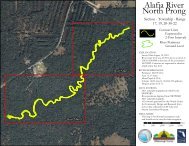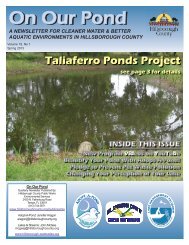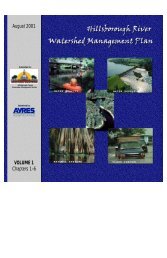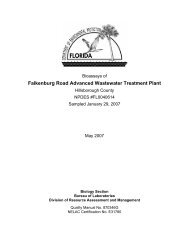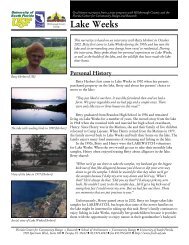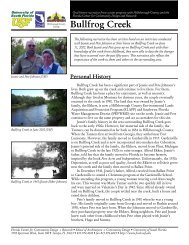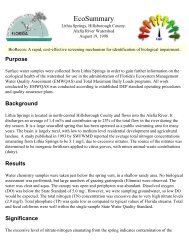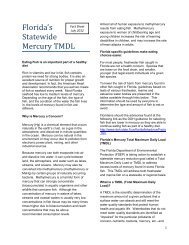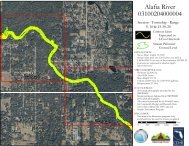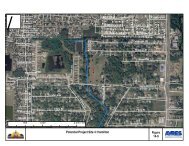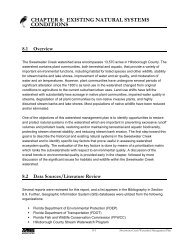Rocky Brushy Creek Watershed Mgmt. Plan (2007) -- Part 2
Rocky Brushy Creek Watershed Mgmt. Plan (2007) -- Part 2
Rocky Brushy Creek Watershed Mgmt. Plan (2007) -- Part 2
Create successful ePaper yourself
Turn your PDF publications into a flip-book with our unique Google optimized e-Paper software.
CHAPTER 8consist solely of mud into which animals burrow. The areal coverage of this habitat has remainedstable at about 0.7% of the watershed.Streams and waterways (510)While <strong>Rocky</strong> <strong>Creek</strong> - <strong>Brushy</strong> <strong>Creek</strong> is a majorlandscape feature and the only linearwaterway in the watershed, it is not identifiedin either the 1950 land use mapping due to itschannel and flow characteristics. The 2004mapping recognizes this community asoccupying 0.2% of the watershed. Thechannel of <strong>Brushy</strong> <strong>Creek</strong> is narrow along itsentire length, while that of <strong>Rocky</strong> <strong>Creek</strong> isnarrow in its upper reaches but widens as the<strong>Creek</strong> approaches the bay. A segment of<strong>Rocky</strong> <strong>Creek</strong> was channelized and adiversion canal, Channel A, was constructed off of <strong>Rocky</strong> <strong>Creek</strong> east of Sheldon Road. Channel Aempties into the bay west of the original channel of <strong>Rocky</strong> <strong>Creek</strong>. The increase in Streams andWaterways in the 2004 mapping to 0.2% reflects the construction of Channel A. The plantcommunity supported on the <strong>Creek</strong> banks in its upper reaches is included under the Stream andLake Swamp community description (FLUCFCS 615); in the lower reaches, the land cover typesinclude tidal flats/submerged shallow platform (FLUCFCS 651). Saltwater marshes (FLUCFCS642) occupy the channel banks in these areas. However, the <strong>Creek</strong> itself should be recognized forits habitat and habitat support functions. Although flow is not continuous along the entire <strong>Creek</strong>channel all year, the <strong>Creek</strong> does support plant species valuable for water quality and wildlife foodand habitat purposes.Lakes (520)/Reservoirs (530)Lakes are defined by FLUCFCS as inland water bodies excluding reservoirs. In the <strong>Rocky</strong> <strong>Creek</strong> -<strong>Brushy</strong> <strong>Creek</strong> watershed, lakes are water bodies ranging in surface area from less than 12 acres to52 acres. The larger lakes in the watershed are: Fairy (52 ac), Hixon (21 ac), and Glass Lake (18ac). These water features are permanently inundated, although water elevations rise and fall as aresult of rainfall. Most lakes have undergone some degree of development on bordering lands;however, some cypress swamp and wetland coniferous forests remain on lake margins. The lakesalso support in-lake plant communities that are valuable in terms of fish production and waterquality functions. <strong>Plan</strong>t communities include emergent aquatic species along the shallow lakemargins and rooted submerged aquatic species in the deeper zones of the lakes. The arealcoverage of lakes in the watershed has increased from 1.1% in 1960 to 4.4% in 2004.Reservoirs are artificial impoundments of water. Not recognized in the land use mapping of 1950,this community type occupies (2004) 4% of the watershed. These water features have beenconstructed in association with agricultural and residential development in the watershed;residential reservoirs are managed to provide aesthetic or stormwater management functions.8-13<strong>Rocky</strong>/<strong>Brushy</strong> <strong>Creek</strong> <strong>Watershed</strong> Management <strong>Plan</strong>



